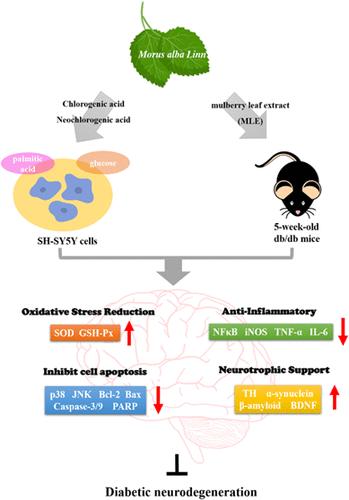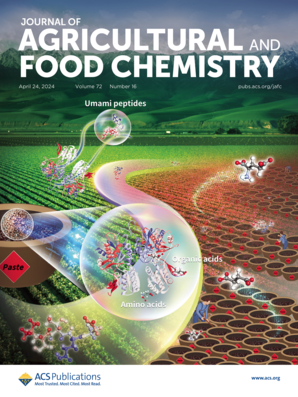The Neuroprotective Effects of Primary Functional Components Mulberry Leaf Extract in Diabetes-Induced Oxidative Stress and Inflammation
IF 5.7
1区 农林科学
Q1 AGRICULTURE, MULTIDISCIPLINARY
引用次数: 0
Abstract
Diabetes-associated neurodegeneration may result from increased oxidative stress in the brain under hyperglycemic conditions, which leads to neuronal cell death. The current study employs the neuroblastoma cell line SH-SY5Y and db/db mouse model of diabetes maintained on a high-fat diet to investigate the neuroprotective effects of the primary functional components of mulberry (Morus alba Linn) leaf extract (MLE), chlorogenic acid (CGA), and neochlorogenic acid (NCGA). CGA and NCGA demonstrated the ability to enhance the activities of the antioxidant enzymes superoxide dismutase and glutathione peroxidase, and attenuate inflammation via regulating nuclear factor erythroid 2-related factor 2 (Nrf2), nuclear factor-κB (NFκB), and inflammatory cytokines, thereby protecting SH-SY5Y cells from oxidative damage induced by palmitic acid and high glucose. CGA and NCGA were found to decrease the expression of proinflammatory proteins α-synuclein and amyloid-β (Aβ). In addition, CGA and NCGA treatments increased the expression of tyrosine hydroxylase (TH) and brain-derived neurotrophic factor (BDNF). Furthermore, MLE supplementation in the animal model resulted in decreased levels of α-synuclein and Aβ concomitant with an elevated expression of TH. These experimental findings suggest that the neuroprotective effects of CGA and NCGA may be mediated via three pathways: reducing oxidative stress, decreasing neuronal inflammation, and enhancing BDNF expression.

求助全文
约1分钟内获得全文
求助全文
来源期刊
CiteScore
9.90
自引率
8.20%
发文量
1375
审稿时长
2.3 months
期刊介绍:
The Journal of Agricultural and Food Chemistry publishes high-quality, cutting edge original research representing complete studies and research advances dealing with the chemistry and biochemistry of agriculture and food. The Journal also encourages papers with chemistry and/or biochemistry as a major component combined with biological/sensory/nutritional/toxicological evaluation related to agriculture and/or food.

 求助内容:
求助内容: 应助结果提醒方式:
应助结果提醒方式:


